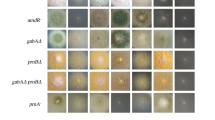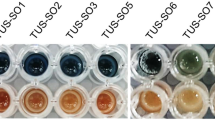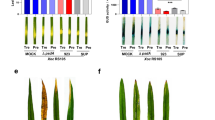Abstract
Nitroaromatic compounds are typically toxic and resistant to degradation. Bradyrhizobium species strain JS329 metabolizes 5-nitroanthranilic acid (5NAA), which is a molecule secreted by Streptomyces scabies, the plant pathogen responsible for potato scab. The first biodegradation enzyme is 5NAA-aminohydrolase (5NAA-A), a metalloprotease family member that converts 5NAA to 5-nitrosalicylic acid. We characterized 5NAA-A biochemically and obtained snapshots of its mechanism. 5NAA-A, an octamer that can use several divalent transition metals for catalysis in vitro, employs a nucleophilic aromatic substitution mechanism. Unexpectedly, the metal in 5NAA-A is labile but is readily loaded in the presence of substrate. 5NAA-A is specific for 5NAA and cannot hydrolyze other tested derivatives, which are likewise poor inhibitors. The 5NAA-A structure and mechanism expand our understanding of the chemical ecology of an agriculturally important plant and pathogen, and will inform bioremediation and biocatalytic approaches to mitigate the environmental and ecological impact of nitroanilines and other challenging substrates.
This is a preview of subscription content, access via your institution
Access options
Subscribe to this journal
Receive 12 print issues and online access
$259.00 per year
only $21.58 per issue
Buy this article
- Purchase on Springer Link
- Instant access to full article PDF
Prices may be subject to local taxes which are calculated during checkout




Similar content being viewed by others
Accession codes
References
McGuinness, M. & Dowling, D. Plant-associated bacterial degradation of toxic organic compounds in soil. Int. J. Environ. Res. Public Health 6, 2226–2247 (2009).
Davies, J. Small molecules: the lexicon of biodiversity. J. Biotechnol. 129, 3–5 (2007).
Spain, J.C. Biodegradation of nitroaromatic compounds. Annu. Rev. Microbiol. 49, 523–555 (1995).
Symons, Z.C. & Bruce, N.C. Bacterial pathways for degradation of nitroaromatics. Nat. Prod. Rep. 23, 845–850 (2006).
Ju, K.S. & Parales, R.E. Nitroaromatic compounds, from synthesis to biodegradation. Microbiol. Mol. Biol. Rev. 74, 250–272 (2010).
Parry, R., Nishino, S. & Spain, J. Naturally-occurring nitro compounds. Nat. Prod. Rep. 28, 152–167 (2011).
Winkler, R. & Hertweck, C. Biosynthesis of nitro compounds. ChemBioChem 8, 973–977 (2007).
Kobayashi, A., Kobayashi, Y.O., Someya, N. & Ikeda, S. Community analysis of root- and tuber-associated bacteria in field-grown potato plants harboring different resistance levels against common scab. Microbes Environ. 30, 301–309 (2015).
Compant, S., Duffy, B., Nowak, J., Clément, C. & Barka, E.A. Use of plant growth-promoting bacteria for biocontrol of plant diseases: principles, mechanisms of action, and future prospects. Appl. Environ. Microbiol. 71, 4951–4959 (2005).
Diallo, S. et al. Mechanisms and recent advances in biological control mediated through the potato rhizosphere. FEMS Microbiol. Ecol. 75, 351–364 (2011).
King, R.R., Lawrence, C.H. & Calhoun, L.A. Unusual production of 5-nitroanthranilic acid by Streptomyces scabies. Phytochemistry 49, 1265–1267 (1998).
King, R.R. & Calhoun, L.A. The thaxtomin phytotoxins: sources, synthesis, biosynthesis, biotransformation and biological activity. Phytochemistry 70, 833–841 (2009).
Lerat, S., Simao-Beaunoir, A.M. & Beaulieu, C. Genetic and physiological determinants of Streptomyces scabies pathogenicity. Mol. Plant Pathol. 10, 579–585 (2009).
Qu, Y. & Spain, J.C. Biodegradation of 5-nitroanthranilic acid by Bradyrhizobium sp. strain JS329. Appl. Environ. Microbiol. 76, 1417–1422 (2010).
Prashar, P., Kapoor, N. & Sachdeva, S. Rhizosphere: its structure, bacterial diversity and significance. Rev. Environ. Sci. Biotechnol. 13, 63–77 (2014).
Qu, Y. & Spain, J.C. Molecular and biochemical characterization of the 5-nitroanthranilic acid degradation pathway in Bradyrhizobium sp. strain JS329. J. Bacteriol. 193, 3057–3063 (2011).
Conticello, S.G., Langlois, M.A. & Neuberger, M.S. Insights into DNA deaminases. Nat. Struct. Mol. Biol. 14, 7–9 (2007).
Boyen, A. et al. Acetylornithine deacetylase, succinyldiaminopimelate desuccinylase and carboxypeptidase G2 are evolutionarily related. Gene 116, 1–6 (1992).
Makarova, K.S. & Grishin, N.V. The Zn-peptidase superfamily: functional convergence after evolutionary divergence. J. Mol. Biol. 292, 11–17 (1999).
Rowsell, S. et al. Crystal structure of carboxypeptidase G2, a bacterial enzyme with applications in cancer therapy. Structure 5, 337–347 (1997).
Shi, D., Yu, X., Roth, L., Tuchman, M. & Allewell, N.M. Structure of a novel N-acetyl-L-citrulline deacetylase from Xanthomonas campestris. Biophys. Chem. 126, 86–93 (2007).
Nocek, B.P., Gillner, D.M., Fan, Y., Holz, R.C. & Joachimiak, A. Structural basis for catalysis by the mono- and dimetalated forms of the dapE-encoded N-succinyl-L,L-diaminopimelic acid desuccinylase. J. Mol. Biol. 397, 617–626 (2010).
Martínez-Rodríguez, S. et al. Mutational and structural analysis of L-N-carbamoylase reveals new insights into a peptidase M20/M25/M40 family member. J. Bacteriol. 194, 5759–5768 (2012).
Maret, W. & Li, Y. Coordination dynamics of zinc in proteins. Chem. Rev. 109, 4682–4707 (2009).
Bar-Even, A. et al. The moderately efficient enzyme: evolutionary and physicochemical trends shaping enzyme parameters. Biochemistry 50, 4402–4410 (2011).
Michaelis, L., Menten, M.L., Johnson, K.A. & Goody, R.S. The original Michaelis constant: translation of the 1913 Michaelis-Menten paper. Biochemistry 50, 8264–8269 (2011).
Jefferson, J.R., Hunt, J.B. & Ginsburg, A. Characterization of indo-1 and quin-2 as spectroscopic probes for Zn2(+)-protein interactions. Anal. Biochem. 187, 328–336 (1990).
Foster, A.W., Osman, D. & Robinson, N.J. Metal preferences and metallation. J. Biol. Chem. 289, 28095–28103 (2014).
Wang, D., Hurst, T.K., Thompson, R.B. & Fierke, C.A. Genetically encoded ratiometric biosensors to measure intracellular exchangeable zinc in Escherichia coli. J. Biomed. Opt. 16, 087011 (2011).
Pelmenschikov, V., Blomberg, M.R.A. & Siegbahn, P.E. A theoretical study of the mechanism for peptide hydrolysis by thermolysin. J. Biol. Inorg. Chem. 7, 284–298 (2002).
Slobodkin, A., Reysenbach, A.L., Mayer, F. & Wiegel, J. Isolation and characterization of the homoacetogenic thermophilic bacterium Moorella glycerini sp. nov. Int. J. Syst. Bacteriol. 47, 969–974 (1997).
Silverman, R.B. in The Organic Chemistry of Enzyme-Catalyzed Reactions 2nd edn., Ch. 6, 251–288 (Academic Press, 2002).
Feig, A.L. & Uhlenbeck, O.C. in The RNA world: The Nature of Modern RNA Suggests a Prebiotic RNA 2nd edn. (eds. Gesteland R.F., Cech T. & Atkins J.F.) Chapter 12, 287–319 (Cold Spring Harbor Laboratory Press, 1999).
Adams, J.A. Kinetic and catalytic mechanisms of protein kinases. Chem. Rev. 101, 2271–2290 (2001).
Steitz, T.A. DNA polymerases: structural diversity and common mechanisms. J. Biol. Chem. 274, 17395–17398 (1999).
Armstrong, R.N., Kondo, H., Granot, J., Kaiser, E.T. & Mildvan, A.S. Magnetic resonance and kinetic studies of the manganese(ii) ion and substrate complexes of the catalytic subunit of adenosine 3′,5′-monophosphate dependent protein kinase from bovine heart. Biochemistry 18, 1230–1238 (1979).
Culotta, V.C. & Daly, M.J. Manganese complexes: diverse metabolic routes to oxidative stress resistance in prokaryotes and yeast. Antioxid. Redox Signal. 19, 933–944 (2013).
Lambert, D.H., Powelson, M.L. & Stevenson, W.R. Nutritional interactions influencing diseases of potato. Am. J. Pot. Res. 82, 309–319 (2005).
Cvetkovic, A. et al. Microbial metalloproteomes are largely uncharacterized. Nature 466, 779–782 (2010).
Gerlt, J.A. & Babbitt, P.C. Divergent evolution of enzymatic function: mechanistically diverse superfamilies and functionally distinct suprafamilies. Annu. Rev. Biochem. 70, 209–246 (2001).
Orwig, S.D. & Lieberman, R.L. Biophysical characterization of the olfactomedin domain of myocilin, an extracellular matrix protein implicated in inherited forms of glaucoma. PLoS One 6, e16347 (2011).
Otwinowski, Z. & Minor, W. Processing of X-ray diffraction data collected in oscillation mode. Methods Enzymol. 276, 307–326 (1997).
Terwilliger, T.C. et al. Decision-making in structure solution using Bayesian estimates of map quality: the PHENIX AutoSol wizard. Acta Crystallogr. D Biol. Crystallogr. 65, 582–601 (2009).
McCoy, A.J. et al. Phaser crystallographic software. J. Appl. Crystallogr. 40, 658–674 (2007).
Emsley, P., Lohkamp, B., Scott, W.G. & Cowtan, K. Features and development of Coot. Acta Crystallogr. D Biol. Crystallogr. 66, 486–501 (2010).
Adams, P.D. et al. PHENIX: a comprehensive Python-based system for macromolecular structure solution. Acta Crystallogr. D Biol. Crystallogr. 66, 213–221 (2010).
Moriarty, N.W., Grosse-Kunstleve, R.W. & Adams, P.D. electronic Ligand Builder and Optimization Workbench (eLBOW): a tool for ligand coordinate and restraint generation. Acta Crystallogr. D Biol. Crystallogr. 65, 1074–1080 (2009).
Konarev, P.V., Volkov, V.V., Sokolova, A.V., Koch, M.H.J. & Svergun, D.I. PRIMUS: a Windows PC-based system for small-angle scattering data analysis. J. Appl. Crystallogr. 36, 1277–1282 (2003).
Svergun, D.I. Restoring low resolution structure of biological macromolecules from solution scattering using simulated annealing. Biophys. J. 76, 2879–2886 (1999).
Volkov, V.V. & Svergun, D.I. Uniqueness of ab initio shape determination in small-angle scattering. J. Appl. Crystallogr. 36, 860–864 (2003).
Kozin, M.B. & Svergun, D.I. Automated matching of high- and low-resolution structural models. J. Appl. Crystallogr. 34, 33–41 (2001).
McWilliam, H. et al. Analysis tool web services from the EMBL-EBI. Nucleic Acids Res. 41, W597–W600 (2013).
Tung, C.H., Huang, J.W. & Yang, J.M. Kappa-alpha plot derived structural alphabet and BLOSUM-like substitution matrix for rapid search of protein structure database. Genome Biol. 8, R31 (2007).
Krissinel, E. & Henrick, K. Inference of macromolecular assemblies from crystalline state. J. Mol. Biol. 372, 774–797 (2007).
Chovancova, E. et al. CAVER 3.0: a tool for the analysis of transport pathways in dynamic protein structures. PLoS Comput. Biol. 8, e1002708 (2012).
Schwede, T., Kopp, J., Guex, N. & Peitsch, M.C. SWISS-MODEL: An automated protein homology-modeling server. Nucleic Acids Res. 31, 3381–3385 (2003).
Kozakov, D. et al. The FTMap family of web servers for determining and characterizing ligand-binding hot spots of proteins. Nat. Protoc. 10, 733–755 (2015).
Tamura, K., Stecher, G., Peterson, D., Filipski, A. & Kumar, S. MEGA6: Molecular Evolutionary Genetics Analysis version 6.0. Mol. Biol. Evol. 30, 2725–2729 (2013).
Edgar, R.C. MUSCLE: multiple sequence alignment with high accuracy and high throughput. Nucleic Acids Res. 32, 1792–1797 (2004).
Jones, D.T., Taylor, W.R. & Thornton, J.M. The rapid generation of mutation data matrices from protein sequences. Comput. Appl. Biosci. 8, 275–282 (1992).
Acknowledgements
This work was funded in part by a Pew Scholar and NSF CAREER award (0845445) to R.L.L., a Georgia Tech Molecular Biophysics Training Award to S.K., a Petit Undergraduate Research Fellowship and a President's Undergraduate Research Award to D.P.H., and a Georgia Internship for Teachers award to C.M.B. Use of the Advanced Photon Source was supported by the US Department of Energy, Office of Science, Office of Basic Energy Sciences, under Contract No. W-31-109-Eng-38. Work performed at Bio-CAT was supported by NIH NIGMS 9P41 GM103622. Use of the Pilatus 3 1M detector was provided by NIGMS 1S10OD018090-01.
Author information
Authors and Affiliations
Contributions
S.K., R.L.L., D.P.H., and J.C.S. designed experiments. S.K., D.P.H., C.M.B., and Z.K. conducted enzymatic assays. S.K., D.P.H., and R.L.L. solved, refined, and analyzed crystal structures. C.M.B. and C.U.U. cloned, expressed, and purified enzymes. S.C. acquired and analyzed SAXS data. R.L.L., J.C.S., S.K., and D.P.H. wrote the manuscript.
Corresponding author
Ethics declarations
Competing interests
The authors declare no competing financial interests.
Supplementary information
Supplementary Text and Figures
Supplementary Results, Supplementary Tables 1–2 and Supplementary Figures 1–7. (PDF 8051 kb)
Supplementary Dataset 1
Phylogenetic tree of top 2255 protein sequences related to 5NAA-A. Red: 5NAA-A. (PDF 6829 kb)
Rights and permissions
About this article
Cite this article
Kalyoncu, S., Heaner, D., Kurt, Z. et al. Enzymatic hydrolysis by transition-metal-dependent nucleophilic aromatic substitution. Nat Chem Biol 12, 1031–1036 (2016). https://doi.org/10.1038/nchembio.2191
Received:
Accepted:
Published:
Issue Date:
DOI: https://doi.org/10.1038/nchembio.2191



